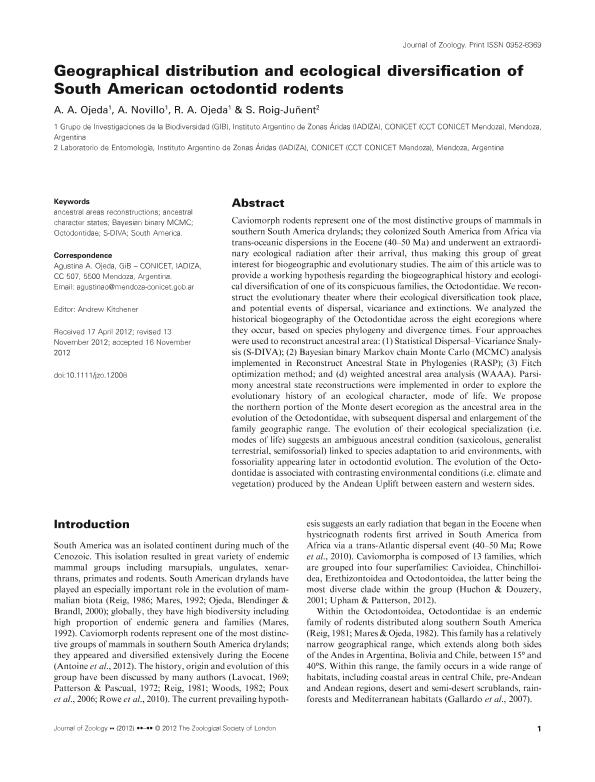Mostrar el registro sencillo del ítem
dc.contributor.author
Ojeda, Agustina Alejandra

dc.contributor.author
Novillo, Agustina

dc.contributor.author
Ojeda, Ricardo Alberto

dc.contributor.author
Roig Junent, Fidel Alejandro

dc.date.available
2015-07-23T12:57:36Z
dc.date.issued
2013-02
dc.identifier.citation
Ojeda, Agustina Alejandra; Novillo, Agustina; Ojeda, Ricardo Alberto; Roig Junent, Fidel Alejandro; Geographical distribution and ecological diversification of South American octodontid rodents; Wiley Blackwell Publishing, Inc; Journal Of Zoology; 2-2013; 285-293
dc.identifier.issn
0952-8369
dc.identifier.uri
http://hdl.handle.net/11336/1415
dc.description.abstract
Caviomorph rodents represent one of the most distinctive groups of mammals in southern South America drylands; they colonized South America from Africa via trans-oceanic dispersions in the Eocene (40-50 Ma) and underwent an extraordinary ecological radiation after their arrival, thus making this group of great interest for biogeographic and evolutionary studies. The aim of this article was to provide a working hypothesis regarding the biogeographical history and ecological diversification of one of its conspicuous families, the Octodontidae. We reconstruct the evolutionary theater where their ecological diversification took place, and potential events of dispersal, vicariance and extinctions. We analyzed the historical biogeography of the Octodontidae across the eight ecoregions where they occur, based on species phylogeny and divergence times. Four approaches were used to reconstruct ancestral area: (1) Statistical Dispersal-Vicariance Snalysis (S-DIVA); (2) Bayesian binary Markov chain Monte Carlo (MCMC) analysis implemented in Reconstruct Ancestral State in Phylogenies (RASP); (3) Fitch optimization method; and (d) weighted ancestral area analysis (WAAA). Parsimony ancestral state reconstructions were implemented in order to explore the evolutionary history of an ecological character, mode of life. We propose the northern portion of the Monte desert ecoregion as the ancestral area in the evolution of the Octodontidae, with subsequent dispersal and enlargement of the family geographic range. The evolution of their ecological specialization (i.e. modes of life) suggests an ambiguous ancestral condition (saxicolous, generalist terrestrial, semifossorial) linked to species adaptation to arid environments, with fossoriality appearing later in octodontid evolution. The evolution of the Octodontidae is associated with contrasting environmental conditions (i.e. climate and vegetation) produced by the Andean Uplift between eastern and western sides.
dc.format
application/pdf
dc.language.iso
eng
dc.publisher
Wiley Blackwell Publishing, Inc

dc.rights
info:eu-repo/semantics/openAccess
dc.rights.uri
https://creativecommons.org/licenses/by-nc-sa/2.5/ar/
dc.subject
ANCESTRAL AREAS RECONSTRUCTIONS
dc.subject
ANCESTRAL CHARACTER STATES
dc.subject
BAYESIAN BINARY MCMC
dc.subject
OCTODONTIDAE
dc.subject
S-DIVA
dc.subject
SOUTH AMERICA
dc.subject.classification
Zoología, Ornitología, Entomología, Etología

dc.subject.classification
Ciencias Biológicas

dc.subject.classification
CIENCIAS NATURALES Y EXACTAS

dc.title
Geographical distribution and ecological diversification of South American octodontid rodents
dc.type
info:eu-repo/semantics/article
dc.type
info:ar-repo/semantics/artículo
dc.type
info:eu-repo/semantics/publishedVersion
dc.date.updated
2016-03-30 10:35:44.97925-03
dc.journal.pagination
285-293
dc.journal.pais
Reino Unido

dc.journal.ciudad
Londres
dc.description.fil
Fil: Ojeda, Agustina Alejandra. Consejo Nacional de Investigaciones Científicas y Técnicas. Centro Científico Tecnológico Conicet - Mendoza. Instituto Argentino de Investigaciones de las Zonas Áridas. Provincia de Mendoza. Instituto Argentino de Investigaciones de las Zonas Áridas. Universidad Nacional de Cuyo. Instituto Argentino de Investigaciones de las Zonas Áridas; Argentina
dc.description.fil
Fil: Novillo, Agustina. Consejo Nacional de Investigaciones Científicas y Técnicas. Centro Científico Tecnológico Conicet - Mendoza. Instituto Argentino de Investigaciones de las Zonas Áridas. Provincia de Mendoza. Instituto Argentino de Investigaciones de las Zonas Áridas. Universidad Nacional de Cuyo. Instituto Argentino de Investigaciones de las Zonas Áridas; Argentina
dc.description.fil
Fil: Ojeda, Ricardo Alberto. Consejo Nacional de Investigaciones Científicas y Técnicas. Centro Científico Tecnológico Conicet - Mendoza. Instituto Argentino de Investigaciones de las Zonas Áridas. Provincia de Mendoza. Instituto Argentino de Investigaciones de las Zonas Áridas. Universidad Nacional de Cuyo. Instituto Argentino de Investigaciones de las Zonas Áridas; Argentina
dc.description.fil
Fil: Roig Junent, Fidel Alejandro. Consejo Nacional de Investigaciones Científicas y Técnicas. Centro Científico Tecnológico Conicet - Mendoza. Instituto Argentino de Investigaciones de las Zonas Áridas. Provincia de Mendoza. Instituto Argentino de Investigaciones de las Zonas Áridas. Universidad Nacional de Cuyo. Instituto Argentino de Investigaciones de las Zonas Áridas; Argentina
dc.journal.title
Journal Of Zoology

dc.relation.alternativeid
info:eu-repo/semantics/altIdentifier/doi/http://dx.doi.org/10.1111/jzo.12008
Archivos asociados
